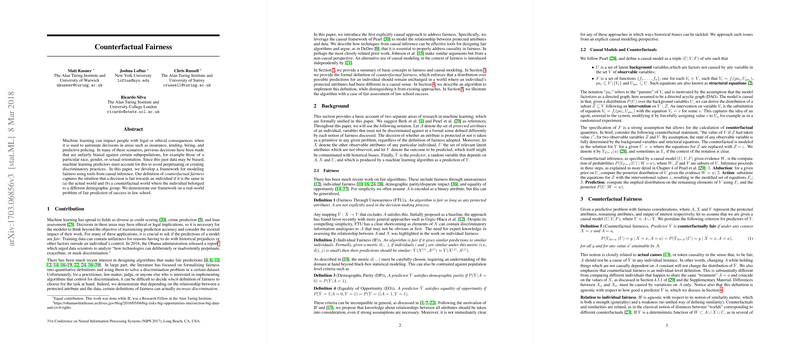Counterfactual Fairness
Introduction
The paper "Counterfactual Fairness" by Kusner et al. presents an innovative approach to assessing and ensuring fairness in machine learning models. The central tenet of the paper is the development of a fairness criterion rooted in causal inference, termed "counterfactual fairness." Unlike prior definitions of fairness that often rely on observed associations, counterfactual fairness leverages the power of counterfactual reasoning to ensure decisions are unbiased. This methodology is particularly pertinent in domains where machine learning algorithms are employed to make impactful decisions, such as in insurance, lending, hiring, and predictive policing. This essay provides a detailed examination of the core contributions, theoretical foundations, practical implications, and potential future directions posited in the paper.
Core Contributions
The authors contribute to the field by offering a robust definition of fairness that addresses biases entrenched in historical data. The paper outlines an approach to modeling fairness using causal inference, specifically through the use of counterfactuals. The key insight here is that a decision is fair if it remains the same in the real world and in a hypothetical world where the individual belonged to a different demographic group. The principal contributions include:
- Definition of Counterfactual Fairness: A formal definition is provided, asserting that a predictor is counterfactually fair if the prediction remains invariant when an individual's demographic attributes are altered in a counterfactual sense.
- Causal Modeling Framework: This framework incorporates causal models to identify relationships between protected attributes and other variables.
- Algorithm for Fair Prediction: An algorithm is presented that leverages the causal model to ensure that predictions are counterfactually fair.
- Case Studies: The authors validate their approach using real-world data, such as the prediction of law school success.
Theoretical Foundations
The paper employs Pearl's causal modeling framework, where a causal model is represented by a directed acyclic graph (DAG) encompassing observable variables , latent variables , and structural equations that define relationships between variables. The causal inference facilitates computation of counterfactuals—hypothetical outcomes for different interventions. Central to counterfactual fairness is the idea that a predictor should not change its output in counterfactual scenarios where the protected attribute (e.g., race or gender) is altered:
for all within the admissible range of .
Practical Implications
Algorithm Implementation
The practical implementation involves several steps:
- Model Specification: Define the causal model and identify non-descendants of protected attributes.
- Parameter Learning: Utilize training data to learn distributions of the latent variables conditional on the observed data.
- Predictor Optimization: Fit a predictor that minimizes the expected loss while satisfying the counterfactual fairness constraint.
The algorithm, titled FairLearning, approximates the distribution of latent variables using MCMC methods and optimizes the predictor using the augmented dataset.
Case Study: Law School Success
An illustrative case paper involves predicting law school success while ensuring predictions are free from racial bias. The paper compares traditional predictors using all available features, predictors excluding protected attributes (unawareness), and the proposed counterfactual fair predictor. Results demonstrated that conventional methods may engrain bias, while the counterfactual fair model ensured fair predictions at a marginal cost to accuracy.
Future Directions
The paper opens multiple avenues for future research. These include:
- Extension to Non-Binary and Multi-Valued Attributes: The framework can be expanded to handle non-binary protected attributes and more complex causal graphs.
- Robustness to Model Misspecification: Investigating the robustness of counterfactual fairness when causal models are mispecified or when latent variables are inaccurately modeled.
- Real-World Deployments and Policy Impact: Applying these models in real-world scenarios to assess long-term impacts and informing policy-making processes.
Conclusion
Kusner et al.'s paper on counterfactual fairness marks a significant step in advancing fair machine learning practices. By grounding fairness definitions in causal inference, the proposed framework ensures that predictions counteract historical biases and discriminatory practices. The theoretical rigor, coupled with practical validation, makes this a seminal work for researchers and practitioners aiming for ethical AI applications. The adoption and further development of counterfactual fairness principles will be instrumental in crafting machine learning models that are not only accurate but also fair and just.
